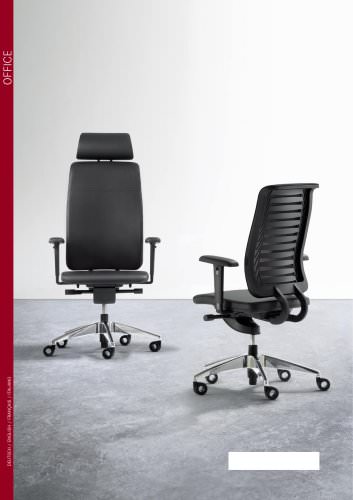
Catalog excerpts

Healthy Sitting
Open the catalog to page 1
Healthy Sitting This brochure provides you with up-to-date information on sitting and tells you about Girsberger chairs’ contributions towards healthy sitting. Health and a seated position are not inconsistent with each other. Although the aim of this brochure is to help you improve your comfort and to show you the correct way of using your office chair, we also hope to awaken your enthusiasm for sitting. 4 6 10 10 12 14 16 17 18 1. The problem facing frequent sitters 2. Anatomy and function of the vertebral column 3. Ergonomics and sitting 4. Focus on the relation between ergonomics and...
Open the catalog to page 3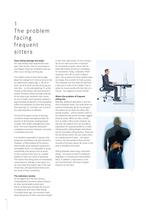
1 The problem facing fr equ e n t sitter s Does sitting damage the body? You may already have experienced neck pain, back tension, lack of concentration and fatigue; these are complaints that can often occur during a working day. The modern world of work has brought about the change from Homo erectus to the so-called Homo sedens (fig. 1). We sit to work, we sit to drive, and we sit during our free time – on the sofa watching TV, at the movies, at the theatre. We have become a society of sitters, without enough exercise. At the same time, backache now counts as one of health care’s greatest...
Open the catalog to page 4
Life is movement The human being was created for movement. Movement boosts the metabolism, which in its turn nourishes the intervertebral discs and encourages the supply of blood (perfusion) to the muscular tissues. Lack of exercise causes deterioration in various parts of the body (bones, muscles, cartilage, nerve cells), whereas movement helps them to develop. The motto “Use it, or lose it” applies. In the end, every static position – be it a standing, lying or sitting one – will lead to metabolic stagnation. Not only do desk workers suffer from loss of well-being and health through lack...
Open the catalog to page 5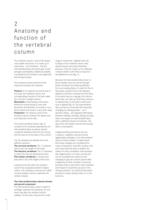
2 An a to my a n d function of th e ve r te b r a l c o lumn The vertebral column is one of the body’s most stable structures. It is made up of hard bones – the vertebrae – and the intervertebral discs and joints give it both strength and flexibility. Additional stability is provided by firm tendons, taut ligaments and strong muscles. The vertebral column performs three important functions for mankind: Posture: In its capacity as central axis of the body, the vertebral column and corresponding muscles of the back stabilize a human’s upright posture. Movement: a fascinating construction...
Open the catalog to page 6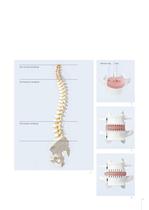
Fibrous ring Core The cervical vertebrae The thoracic vertebrae 4 The lumbar vertebrae 5 5 3 6 7
Open the catalog to page 7
Muscles allow us to retain position and to move Muscles are the active part of the musculoskeletal system. An upright position and movements of the spine are made possible by the muscles of the back. In order to obtain a clearer picture of the complex interaction between vertebrae, ligaments, intervertebral discs, and muscles, one can compare the vertebral column to the mast of a ship, vertically secured by ropes (muscles) to the hull of the ship (pelvis) (fig. 7). If the system is well balanced, then the mast is perpendicular. The pelvis provides a base for the vertebral column and makes...
Open the catalog to page 8
Recommendations Recommendations for healthy sitting are as follows: During active sitting and position changing, the muscles are used dynamically. In addition, by continuously returning to an upright position in which the vertebral column regains its natural S-shape, the sitter distributes pressure evenly over the intervertebral discs. 9
Open the catalog to page 9
3 Er g o n o m i c s a n d sit t i n g 4 Focus on the relation between ergonomics and the chair What are ergonomics? The term ‘ergonomics’ is composed of the Greek words ergon (work) and nomos (law). Ergonomics are the scientific study of the legitimacy of human working conditions. One of this science’s most important duties is to adapt machinery, operating controls, tools, and work environments so that they comply with human needs. The described structure and functions of the vertebral column, the intervertebral discs and the muscles of the back, make it possible for us to determine what...
Open the catalog to page 10
The level of ergonomic relation and relevant user behaviour Healthy sitting can therefore develop when ideal ergonomic conditions are coupled with ideal use. To focus solely on the ergonomic conditions offered by the chair – a relationlinked aspect – is not enough. In order to be able to make the correct adjustments and use the chair in the best possible way, it is equally important that each of the chair’s functions are correctly understood. This means that a comprehensive concept for health, efficiency, and comfort at the workplace must take both the extent of ergonomic relation and that...
Open the catalog to page 11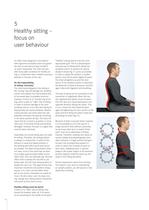
5 Healthy sitting – focus on user behaviour An office chair designed in accordance with ergonomic principles does not guarantee that its user will not have trouble if he uses it frequently. The chair will only offer favourable conditions for healthy sitting in combination with a health-conscious attitude on the part of the user. On the impossibility of sitting “correctly” The often-heard allegation that sitting in the “wrong” way will damage the vertebral column and subject the intervertebral disc to increased wear is probably incorrect. However, if there is no “wrong” way of sitting, there...
Open the catalog to page 12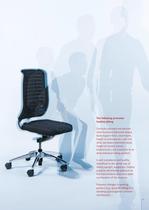
The following promotes healthy sitting Correctly adjusted and attuned chair functions (backrest height, back support force, seat height, height of armrests etc.) and the other workplace elements (desk, height of monitor screen, keyboard etc.) are conducive to an ideal individual sitting position. A well considered and healthy (beneficial to the spine) way of sitting (upright, supported, mobile) prevents detrimental pressure on the intervertebral discs and static overtaxation of the muscles. Frequent changes in working position (e.g. dynamic sitting and standing) guard against constant...
Open the catalog to page 13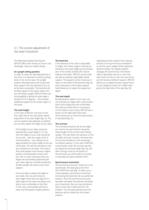
5.1. The correct adjustment of the chair’s functions The following example featuring the REFLEX office chair shows you how to use Girsberger chairs for healthy sitting. An upright sitting position In order to make the ideal adjustments to the chair, it is important to start by sitting down in the correct way. The upright position described above will receive the best support from the backrest if you sit as far back as possible. The backrest will provide support to the pelvic region and you will remain upright. REFLEX offers you the possibility of giving the seat angle a forward tilt of 4...
Open the catalog to page 14All Girsberger catalogs and technical brochures
-
Barra Round
8 Pages
-
Akio Steel
8 Pages
-
La Punt
14 Pages
-
Marva Data | Facts
4 Pages
-
Andra
8 Pages
-
Simplex
8 Pages
-
Diagon
8 Pages
-
Misura
6 Pages
-
Linked
8 Pages
-
Otto
8 Pages
-
Jack
8 Pages
-
Joline
8 Pages
-
Pablo Modular
8 Pages
-
Sibora
6 Pages
-
Linq
8 Pages
-
Lana
8 Pages
-
Alambre
6 Pages
-
Kuba
6 Pages
-
Nava
8 Pages
-
Yoho
6 Pages
-
Estudio
8 Pages
-
Akio
8 Pages
-
Camiro (cantilever chair)
6 Pages
-
Camiro
8 Pages
-
G 125
8 Pages
-
Pablo Armchair
1 Pages
-
Anto
4 Pages
-
Onda
4 Pages
-
Nur
4 Pages
-
Bela
4 Pages
-
New products dining 2014
12 Pages
-
Sustainability Report
46 Pages
-
Service & Remanufacturing
32 Pages
-
Customized furniture
30 Pages
-
Dining
48 Pages
-
Office
46 Pages
-
Dining Colours
26 Pages
-
Office Colours
46 Pages
Archived catalogs
-
HOME Brochure
52 Pages
-
PERMESSO
2 Pages
-
FOLIO
4 Pages
-
OFFICE Brochure
36 Pages
-
TAMINO
2 Pages
-
BALZARO
2 Pages
-
REFLEX
4 Pages
-
CONTACT
4 Pages












































